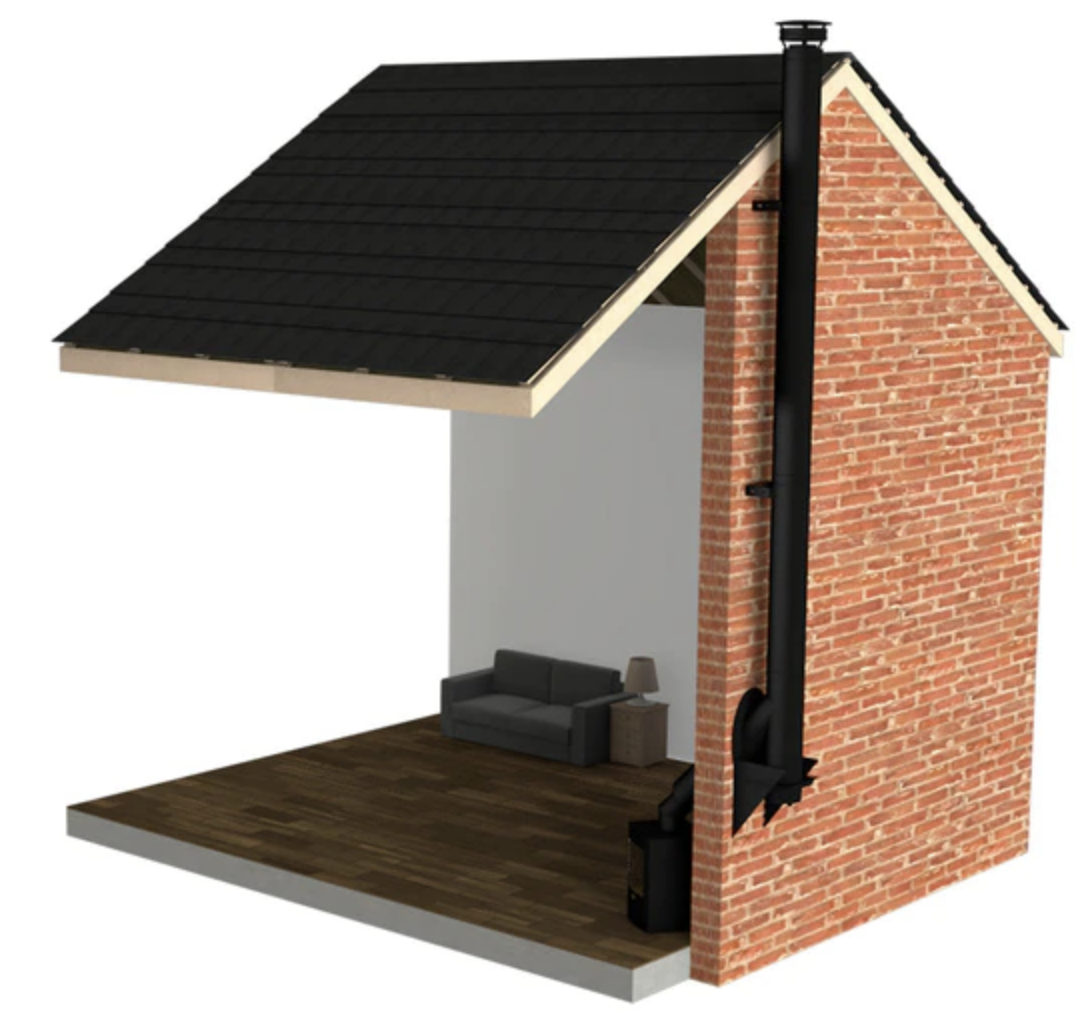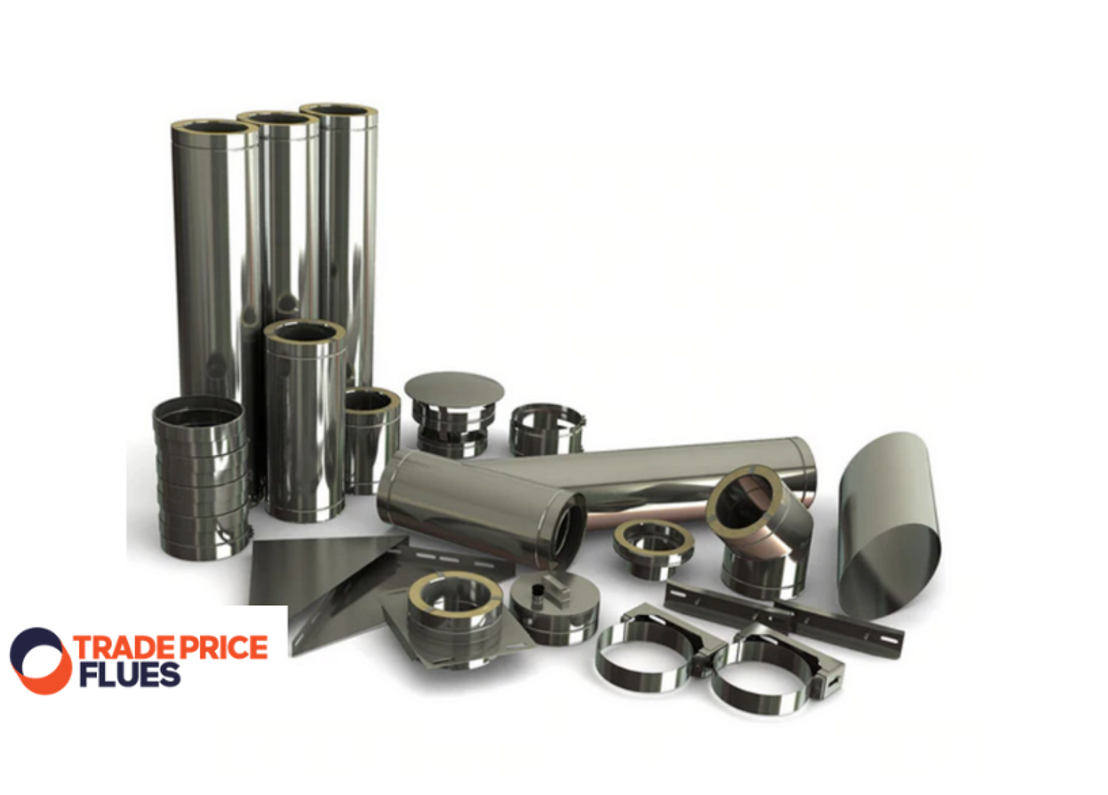What Is a Balanced Flue & How to Install One
If you’re looking to buy a new fire or stove you may have encountered the term ‘balanced flue’ and wondered what it meant. If that’s the case, keep on reading as we explain what a balanced flue is and how to install one.
What kind of fires or stoves need balanced flues?
Before we go on to explain what a balanced flue is, we thought we’d first explain what kind of fires actually need a balanced flue.
The answer is fairly simple. Balanced flues can only be used with glass fronted fires, where the appliance is ‘sealed’ from the room it is in. Any flames or combustibles are contained behind the heat resistant glass.
In practice, this means that balanced flues are almost always used with gas fires.
How will I know if I need a balanced flue?
Balanced flues were developed so that homes that don’t have traditional chimneys (or any chimney at all) could safely install and use gas appliances.
Balanced flues rose in popularity from the 1960s and 1970s onwards when house building techniques changed, with many new build homes no longer being built with chimneys.
So, if you’re looking to install a new gas fire or stove in your home and you don’t have a chimney, then you’ll need a balanced flue.
If you’re not sure if you actually have a chimney (some homes have artificial fireplaces that don’t connect to a chimney) then contact your local chimney sweep or chimney inspector. They’ll be able to provide you with a definitive answer on this.
On a related note, if you’re worried that getting a balanced flue installed could be a big job, don’t. Fitting a balanced flue is straightforward in most homes and often involves very little construction work.
Note - If you find that you need a balanced flue installing your home, make sure that you buy a balanced flue fire or stove. A balanced flue will only work with a balanced flue compatible appliance.
What are balanced flues and how do they work?
Now that we’ve set out the instances in which you will require a balanced flue, let’s take a look at what balanced flues actually are and how they function.
The easiest way to explain how a balanced flue works is by comparing it to a traditional flue.
In a traditional flue, the appliance expels its fumes into the flue which then carries them up the chimney and out into the open air and away from your home. By contrast, with a balanced flue appliance, the fumes are expelled into an ‘exhaust’ (often referred to as a twin wall pipe). This exhaust is normally placed horizontally through the wall - so fumes are pushed out into the open at street level (rather than running up a chimney. However, balanced flues can also run vertically).
There are some other important ways in which a balanced flue differs from a traditional flue.
With a traditional (or open) flue system the oxygen that is required to feed the fire is drawn from the room (either directly in the case of an open fire or via vents if the front of the fire is closed off). This is why, if you buy a traditional wood or multi fuel appliance, you have to make sure you have sufficient ventilation and air supply in your room.
A balanced flue on the other hand, draws its oxygen from outside your home via an intake pipe (hence the twin wall pipe reference earlier). In other words, the pipe that passes through the wall that expels the fumes, also pulls in fresh air from the outside to keep your fire fed with oxygen (think of it like a smaller tube inside a larger tube - one taking air in, the other expelling fumes).
Are balanced flues good?
You’d be forgiven if you thought that balanced flues sound complicated. You’d also be forgiven if you thought that their complexity makes them no good. But you’d be wrong.
Balanced flues have a number of benefits that you don’t get with other types of flues.
Here are some of the benefits of balanced flues and balanced flue gas fires:
> Simple installation - a balanced flue can fit through almost any type of external wall. You don’t need to worry about having a chimney and all of the complications that can accompany them. Plus, because the twin wall pipe (the exhaust and intake pipes) sit at ground level, you don’t need to worry about scaffolding or working at height.
> Thermal efficiency - because they are sealed units, balanced flues are highly efficient - especially compared to open fires. Balanced flue gas fires can be over 90% efficient, as no heat is lost up a chimney.
> You don’t need additional ventilation - as we mentioned earlier, open fires require extensive ventilation to function properly. This can often mean you have to undertake construction work to create additional ventilation. With a balanced flue gas fire you don’t have to worry about any of this. A balanced flue is sealed and draws its oxygen from outside your home.
> Plenty of style options - because you aren’t limited by a traditional chimney, balanced flue gas stoves and fireplaces are available in a huge array of different styles. You’ll have much more choice when it comes to aligning the look of your fireplace to the rest of your room.
> Resistance to gusts of wind - if you’ve ever had a traditional open fireplace you’ll know that windy, gusty weather can affect your fire. With a balanced flue, the closed nature of the system minimises the impact of gusts of wind on the performance of your fire.
What if I already have a chimney?
So far, we’ve highlighted the benefits of balanced flues for people whose homes don’t have chimneys. However, if you do have a chimney, you may be able to convert it to accommodate a balanced flue.
If you have a Class 1 chimney then it is possible to convert it. Your chimney will need to be closed off, with the balanced flue installed through the wall. You’ll be able to install your new appliance in the chimney breast cavity, but the fumes will be expelled via the flue through the wall, rather than being drawn up through the chimney.
Okay, so now you’ve read about what a balanced flue is, you may be wanting more details about the installation process. If that’s you, then carry on reading as the next section will look at how you install a balanced flue.

(Pictured: Twin Wall Flue Kit - 5” Stainless Steel - Single Storey External System).
How do you install a balanced flue?
As we mentioned earlier, installing a balanced flue may sound like a big job, but it’s actually quite straightforward and can be done in a short period of time.
Before picking up the tools though, make sure you’re familiar with the building regulations for balanced flues.
Building regulations for balanced flues
The installation of a balanced flue gas fire must adhere to building regulations. If you’re unsure what your local building regulations are, contact the relevant department within your local authority.
Full details of the building regulations can be found in the Approved Document J (England and Wales), which you can read here.
Some of the key regulations include:
> The flue terminal should not be nearer than 300mm to an opening in the building fabric formed for the purpose of accommodating a built-in element such as a window frame or door frame.
> A guard should be fitted over the flue terminal where the terminal may come into contact with people near the building or be susceptible to damage.
> The balanced flue gas appliance must not be installed against a combustible surface. Combustible surfaces will require shielding in accordance with the relevant building regulations.
> The maximum flue length is 370mm. If the wall thickness exceeds 350mm then the installation cannot proceed.
> The minimum flue length is 105mm.
> You should include a 20mm clearance behind the appliance for ventilation purposes.
This isn’t an exhaustive list of the regulations you may have to adhere to. As we mentioned earlier, if you’re unsure about the regulations that apply to you, contact your local authority.
Installing the appliance
If you are installing a balanced flue gas appliance you should contact a Gas Safe registered engineer to carry out the installation for you.
Whilst it’s not technically illegal to carry out gas work in your home, we strongly suggest that you don’t. It’s extremely important that the gas supply is safely connected to your new appliance.
You can find your local Gas Safe registered gas engineer here.
The assembly process
Even if you do decide to get a Gas Safe engineer to install your balanced flue and appliance for you, it’s still worth knowing the key parts of the installation process.
The installation process will vary depending on what appliance you buy, however key parts of the installation can include:
> Site the appliance - as we mentioned earlier, there are a whole host of regulations that apply to where you can and can’t install your appliance and balanced flue. So, you don’t want to rush this part of the installation. Get this right otherwise the work won’t get signed off by your local building inspector.
> Check the hearth, ventilation and clearance - once you’ve chosen where the appliance and flue will be sited, you should ensure you have an appropriate hearth in place. In addition to a hearth, you should also at this stage ensure there is sufficient ventilation and clearance for the appliance.
> Prepare the gas supply - you should ensure that your domestic gas supply can connect to your new appliance. The gas is usually supplied to an appliance via 8mm (O/O) copper tubing. During the installation process a gas soundness test should be performed to ensure that all existing pipework in the property is sound.
> Unpack and affix the burner bracket - this is the bracket which connects the appliance to the flue.
> Flue pipe assembly and installation - at this point you’ll be drilling a hole through the exterior wall of your property and installing the flue pipe.
> Terminal guard - once the flue pipe has been fixed in place, it’s time to install the terminal guard.
> Install the ceramics - in some appliances, you will need to remove the glass front and install the ceramics (these are what give a traditional look and feel to your fire).
> Run a pressure test - the installer should run a pressure test of the appliance once it has been installed. This will ensure that all of the connections within the appliance are sound.
> Complete a commissioning form - once the installation has been completed, it’s vital that the installer completes a commissioning form. A commissioning form is generally an important part in getting a piece of work signed off.
So there you have it - our guide to balanced flues and their installation process.
If you’re in the market for a balanced flue, then shop our complete range now.
If you’d like some free advice about balanced flues then contact us or use our live chat (you’ll find it on the bottom right of this screen) and we’ll be happy to provide you with our expert advice.
More buying guides and advice you might like…
What is a Twin Wall Flue System? | What is a Balanced Flue? | What Twin Wall Regulations Are There?
Latest Articles
-
Air Pollution Down in the UK Despite Record Wood Burner Sales
Great news! Wood-burning stoves, once considered environmental villains, have transformed into eco-f …18th Apr 2024 -
A Guide to Stove Installation in Lodges, Sheds, and Shepherd’s Huts
Shepherd’s huts, lodges, and sheds have become increasingly popular as charming retreats or alternat …25th Mar 2024 -
Pinned vs. Pinless Moisture Meters: Which is Best for Firewood?
When you collect or buy firewood, it usually starts very moist inside. Using sopping wet wood to bur …4th Mar 2024






